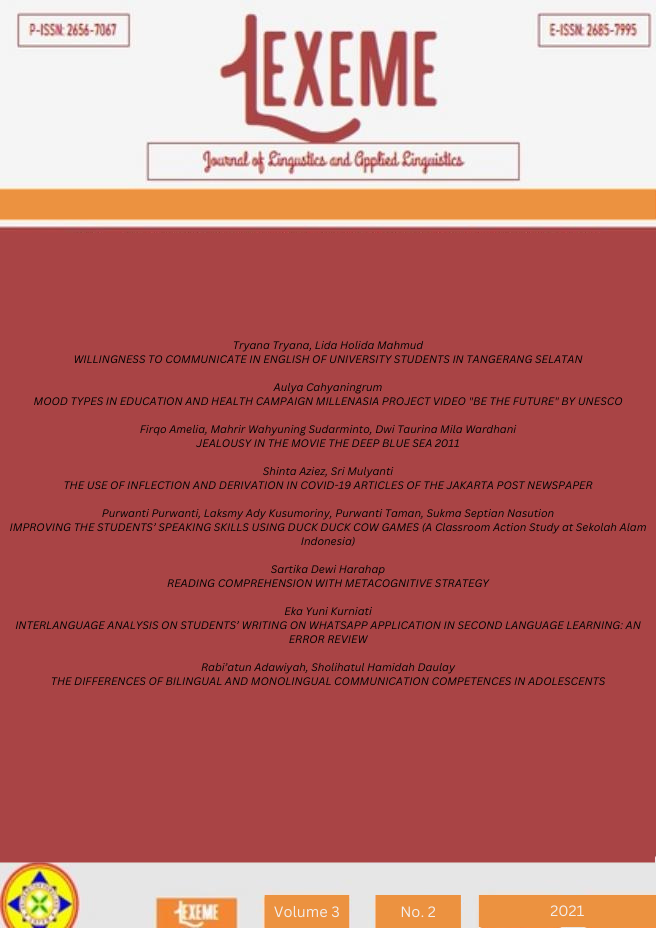WILLINGNESS TO COMMUNICATE IN ENGLISH OF UNIVERSITY STUDENTS IN TANGERANG SELATAN
DOI:
https://doi.org/10.32493/ljlal.v3i2.18028Keywords:
anxiety, communicate, learning, motivation, willingnessAbstract
The fact that Indonesian students’ reticent in speaking English is still found until today. Its phenomena commonly happens in English as a foreign language class. This pattern is related to students’ desires to speak up called Willingness to Communicate (WTC). Willingness to communicate concepts arise in individual’s L1 and L2. However, the present study explored some issues that emerge as a chance for foreign language learners to communicate. In particular, the study investigated an extent in which Indonesian EFL learners are eager to communicate in English. In addition, the study focuses on the correlation between willingness to communicate and language learning anxiety, language learning motivation. and situational influence. Furthermore, the study sees the correlation between willingness to communicate and gendre. The literature review focused on Maclyntre’s Heuristic model on willingness to communicate concepts. Then, It is linked to learning motivation and learning anxiety concepts in EFL class. The study involved a quantitative approach through employing 126 undergraduate students in Tangerang Selatan during the research phase of this project to generate survey data through questionnaires. Questionnaires that support the learner's willingness to communicate espoused from proposed. From the data analysis, it was found that there is correleation between anxiety, motivation and WTC in university students of Tangerang Selatan. However, the impact is low. There are other aspects influencing WTC that should be taken into consideration for further investigation. From the findings, it can be implied that eventhough learning anxiety appears on students learning, students motivation helps them to contend with their impartiality and proficiencies.References
Allen, M. (2017). The SAGE Encyclopedia of Communication Research Methods (vol 1-4). Thousand Oaks, CA: SAGE Publication
Anggraeni, A., & Rachmijati, C. (2017). Aplikasi Pemahaman Lintas Budaya (Cross Cultural Understanding) dalam Pembelajaran Speaking untuk Mengatasi Kecemasan Berbicara (Speaking Anxiety) pada Mahasiswa Semester 2 Program Study Bahasa Inggris STKIP Siliwangi.A . Jurnal Ilmiah P2M STKIP Siliwangi, 4(2), 32-39.
Barlow, D. H., & Allen, L. B. (2004). Scientific Basis of Psychological Treatments for Anxiety Disorders: Past, Present, and Future. In Annual Meeting of the American Psychopathological Association, Mar, 2002, New York, NY, US; Portions of this chapter were presented at the Annual Meeting of the American Psychopathological Association, March 7-9, 2002, in New York City, and the Annual Meeting of the Anxiety Disorders Association of America, March 22, 2002, in Austin, Texas.. American Psychiatric Publishing, Inc.
Cao, Y. (2009). Understanding the notion of interdependence, and the dynamics of willingness to communicate (Doctoral dissertation, ResearchSpace@ Auckland).
Coghlan, D., & Brydon-Miller, M. (Eds.). (2014). The SAGE encyclopedia of action research. Sage.
Rabe-Jabłońska, J., & Bieńkiewicz, W. (1994). Anxiety disorders in the fourth edition of the classification of mental disorders prepared by the American Psychiatric Association: diagnostic and statistical manual of mental disorders (DMS-IV--options book. Psychiatria polska, 28(2), 255.
English First. English Proficiency Index Report 2017
Falk, N. H., Norris, K., & Quinn, M. G. (2014). The factors predicting stress, anxiety and depression in the parents of children with autism. Journal of autism and developmental disorders, 44(12), 3185-3203.
Gardner, R. C. (2001). Integrative motivation and second language acquisition. Motivation and second language acquisition, 23(1), 1-19.
Ginsberg, M. B., & Wlodkowski, R. J. (2009). Diversity and motivation: Culturally responsive teaching in college. John Wiley & Sons.
Halupka-Rešetar, S., Knežević, L., & Topalov, J. (2018). Revisiting willingness to communicate in English as a foreign language: The Serbian perspective. Journal of Multilingual and Multicultural Development, 39(10), 912-924.
MacIntyre, P. D., Clément, R., Dörnyei, Z., & Noels, K. A. (1998). Conceptualizing willingness to communicate in a L2: A situational model of L2 confidence and affiliation. The Modern Language Journal, 82(4), 545-562.
MacIntyre, P. D., Dewaele, J. M., Macmillan, N., & Li, C. (2019). 3. The Emotional Underpinnings of Gardner’s Attitudes and Motivation Test Battery. In Contemporary language motivation theory (pp. 57-79). Multilingual Matters.
McCroskey, J. C. (1992). Reliability and validity of the willingness to communicate scale. Communication Quarterly, 40(1), 16-25.
Xie, Q. M. (2011). Willingness to communicate in English among secondary school students in the rural Chinese English as a foreign language (EFL) classroom (Doctoral dissertation, Auckland University of Technology).
Riasati, M. J. (2018). Willingness to speak English among foreign language learners: A causal model. Cogent Education, 5(1), 1455332.
Sugiyono. (2013). Metode Penelitian Pendidikan Pendekatan Kuantitatif, Kualitatif, dan R&D. Bandung: Alfabeta.







